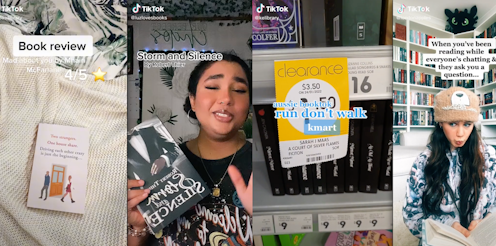What is BookTok, and how is it influencing what Australian teenagers read?
- Written by Katya Johanson, Professor of Audience Research, Deakin University

Video-sharing app TikTok has been credited with making reading[1] “cool again” among teenagers, through the hashtag #BookTok.
Most BookTok posts are playful short videos, no longer than a minute, that match book images to popular soundtracks.
For example, in the ten-second video “YA whoops”[2], prolific Australian BookTokker @londonapples[3], wearing her trademark teddy-bear beanie, appears guiltily surprised when interrupted from her reading.
What are TikTok and BookTok?
TikTok is the fastest growing social media platform in history[4]. It’s most popular among young people.
In 2020, 38% of Australian teens[5] aged 12 to 17 reported spending time on TikTok. Last year, the hours spent by Australian users increased by 40%[6] to 23.4 hours per month.
BookTok is a community of TikTok creators who post videos celebrating their love of books and reading. The hashtag #BookTok[7] now has more than 46 billion views worldwide.
Who watches and creates BookTok videos?
Our Teen Reading survey[8] investigates how Australian teenagers use book-related social media, and who they are.
Preliminary results reveal that while more than half of Australian teenagers use TikTok (56%), a much smaller number engage with “book talk” on social media, including BookTok (16%).
This supports our earlier research[9], which found that regular book talk on social media is the domain of a small yet passionate group of readers. Despite being a small proportion of teenagers, BookTokkers are building sizable social media followings, encouraging other teenagers to read and influencing what they read.
Anecdotal reports by booksellers[10] credit BookTok with sparking a resurgence in reading among young people.
Avid BookTokker Mireille Lee (@alifeofliterature[11]) describes how “I started reading again after six years when I came across BookTok for the first time”.
Until the pandemic, reading rates among teenagers were falling, but the pandemic and the rising popularity of BookTok meant that by 2021, among UK teenagers[12], a third reported reading more often.
Many booksellers now feature a #BookTok table, or publish “trending on #booktok” lists[13] and boxed #booktok sets[14].
The magic of BookTok, in 5 parts
So, how does BookTok work? We’ve identified five key elements.
1. Playful and creative
First, TikTok is a very playful medium. Users can[15] embed, re-use, replicate and imitate other posts in creative ways.
A “stitch” post, for example, allows a user to embed another post within their own, to mimic, critique or add humour. In one example, @penguin_teen uses her “stitch” post[16] to co-opt another user’s advice on not blaming yourself, playfully blaming author Krystal Sutherland for her sleepless night reading her book.
A “duet” similarly embeds another post, but plays it in parallel to their own. For instance, in one post, @hellohardbacks compares[17] @kaitlin.tracy’s pace in reading Samantha Shannon’s doorstopper The Priory of the Orange Tree to her own, in disbelief.
2. Algorithm creates unexpected recommendations
Second, while other platforms recommend content to viewers from the creators they follow, TikTok privileges recommendations based on its algorithm[18], which draws on posts users have viewed, liked and reposted. This can provide unexpected recommendations tailored to a viewer’s individual tastes.
3. Popularity of posts, not creators
Third, TikTok fame is based on the popularity of individual posts, not of creators. Australian BookTokker @hibas.library[19] generally receives views in the low thousands, but one post on “Biggest book related pet peeves”[20] reached over 150k. BookTokker @kelibrary[21]’s account was less than two weeks old when their book bargain post[22] received 393k views.
4. Connects book lovers
Fourth, BookTok creators connect with other book lovers – the platform’s key attraction. @luzlovesbooks[23] explains: “I created my book account because I was longing to find a connection with people about something I am super passionate about.”
This provides a rare opportunity outside school to learn from each other about books, reading and book culture. We explore this sharing as “peer pedagogy”: a process in which young people teach their peers about something that they are passionate about.
5. Emotion is currency
Finally, TikTok’s currency is emotion and it is video-heavy, which together make it a much loved, performative medium among young readers.
This is why books like They Both Die at the End by Adam Silvera (2017) have experienced a spike in sales[24] – because they lend themselves to emotional expression and hyper-visceral performances. It’s common for BookTok videos to feature readers crying[25].
But how is BookTok influencing what young people are reading?
Surprisingly, BookTokkers have been profiling many books that were published several years ago. Publishers are used to most books having a short shelf life, but BookTok is driving unexpected new demand among young readers for older books.

















